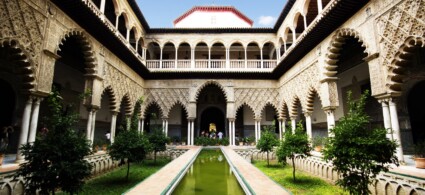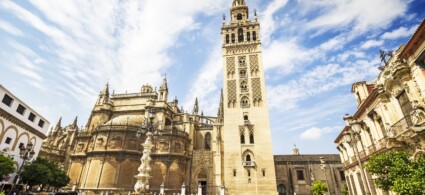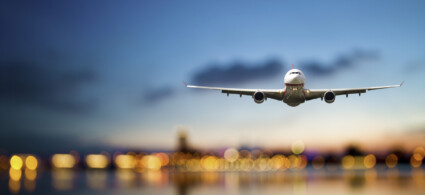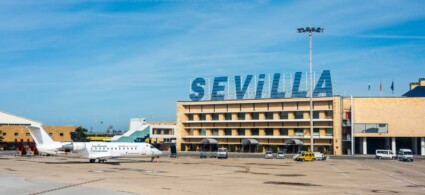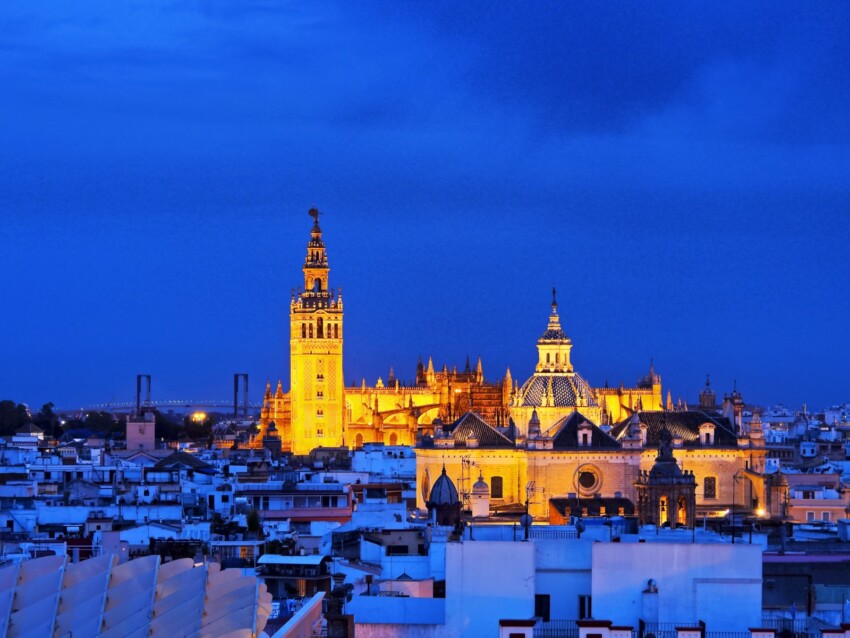

Seville is a seductive sun-kissed queen: one of the three pearls of Andalusia along with Cordoba and Granada, it sums up what has made this extraordinary region famous, considered not without reason one of the most beautiful in all of Spain: Arab architecture, flamenco, traditions and festivals experienced with intense popular participation.
The rays of the powerful Andalusian sun illuminate and enhance the city’s splendid buildings with their unique mix of Roman, Renaissance, Gothic, Islamic and Baroque styles, testimony to the different cultures that have succeeded one another here. Among them, the Alcazar, a magnificent architectural complex, and the immense Cathedral with its Giralda tower, which has become a symbol of the city, will steal your heart.
At night, Seville casts off its elegant ladylike appearance and transforms into an energetic young woman. Its lively nightlife has something for everyone: an incredible amount of traditional tapas bars and bar de copas, trendy clubs, live shows, tablao de flamenco, avant-garde theatres, as well as squares and riverbanks frequented by young people.
Seville is indeed rich in historical and cultural attractions, but you will be able to concentrate the most important ones in a day or two. If you have three or four days, you can allow yourself more time in each museum or monument and add a few less famous attractions as well.
Here are the must-see attractions in Seville.

Seville’s landmark building is the Alcázar, a marvellous fusion of Mudejar and Christian architecture. It is one of the oldest royal sites in Europe and one of the three most important Islamic monuments in Andalusia, along with the Mezquita in Cordoba and the Alhambra in Granada, which are gems of Andalusian tourism.
Built as a fortress in the 10th century, it was enlarged and modified several times during its millennial existence. The result is an architectural complex of inimitable beauty, characterised by an incredible variety of architectural styles, precious and elaborate decorations, splendid hidden cloisters and tropical gardens.
The palace is divided into different sections dating back to different periods: Moorish (11th and 12th centuries), Gothic (13th century), Mudejar (14th century) and Renaissance (15th and 16th centuries). A visit to the Alcazar is like a fascinating walk through the centuries, in a succession of sumptuous rooms, inner courtyards and squares!
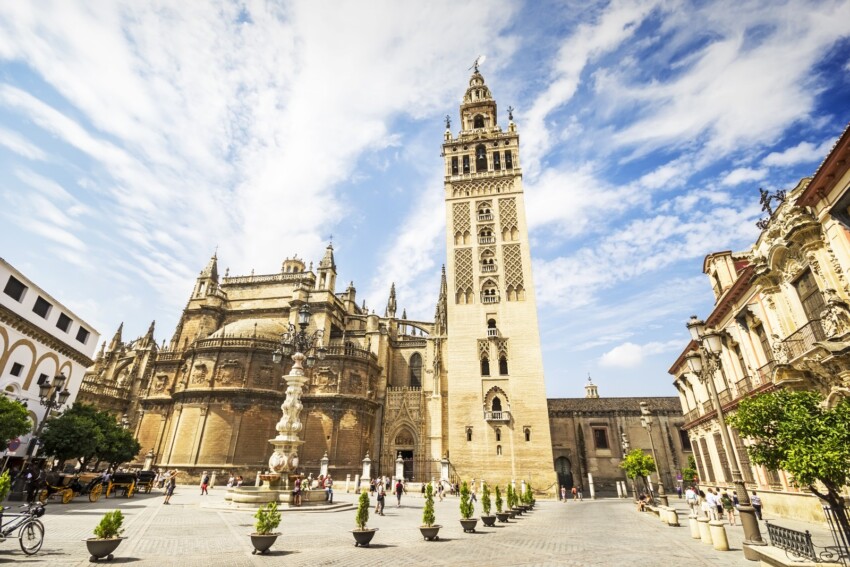
After the Alcazar, the Cathedral is undoubtedly the second most famous and spectacular tourist attraction in Seville. Built on the site of an ancient Almohad mosque, at 126 metres long and 83 metres wide it is the largest cathedral in Spain, and at the same time one of the largest churches in the world. It is a magnificent construction that mixes Gothic and Renaissance elements, with a monumental exterior and an interior rich in decoration and artistic treasures.
Its construction began in 1401, and from then on the building process lasted for hundreds of years, first in Mudejar style, then Gothic, then Renaissance, then Baroque, then Neoclassical and finally Neo-Gothic. A unique mix of styles can be found both inside and out, making this magnificent church one of the landmarks of Seville and the entire Christian world.
Today, the Cathedral of Seville is a must-see attraction in the city. You can visit the interior and exterior on your own, or buy the entrance fee and enjoy all its wonders, including the Patio de los naranjos (i.e. the orange courtyard) and the tomb of Christopher Columbus.
The Giralda Tower is the cathedral’s bell tower, which was the minaret of the original mosque. It is 95 metres high, but you can easily reach the top because the flights of stairs were built wide enough for even guards on horseback to climb! On its top flies El Girardillo, a bronze weathervane that has become the symbol of Seville.
The beating heart of Seville is the Barrio de Santa Cruz, the old Jewish quarter that today serves as the city’s historic centre. It is a maze of narrow, entirely pedestrianised streets, overlooked by small white houses, often with a patio and fountain in the centre, and decorated with ceramic azulejos and green plants to shelter from the scorching Andalusian sun.
Wandering aimlessly through the Barrio de Santa Cruz, you will occasionally come across small squares with orange trees and outdoor tables, including Plaza de Santa Cruz, one of the most picturesque in the city, which incidentally is the one that gives the district its name. Among the streets not to be missed during your visit to the district are Callejon del Agua, which runs along the northern wall of the Alcazar, and Calle Mateos Gago, one of the largest in the district, which connects it to the Cathedral.
Finally, as you leave Barrio de Santa Cruz heading south, you will find the Jardines de Murillo, lush gardens named after the famous Sevillian painter who lived in this area. Don’t miss the chance to rest in the shade of its centuries-old trees!
Let’s move north of the Cathedral, still within the centre of Seville. Here, in Plaza de la Encarnacion, you will find a modern structure that in some ways clashes with the soul of Seville, but on the other hand represents a breath of fresh air that never hurts. It is the Metropol Parasol, also known as Setas de Sevilla (i.e. ‘the mushrooms of Seville’), an enormous pergola of laminated white wood 150 metres wide and about 26 metres high.
At the base of the Metropol Parasol is a traditional market and some restaurants, as well as an open-air performance area and the Antiquarium archaeological museum. At the top, on the other hand, there is a terrace and a beautiful viewpoint, from which a panoramic view of the old quarter of the city of Seville can be admired.
Constructed at the end of 2011 at a cost of 86 million euros, the Metropol Parasol is a work that has split citizens’ opinions since the presentation of the project, but especially afterwards, when it became known that the cost of the work was more than three times the initial estimates. However, it is a fact that since the day of its inauguration it has been one of the city’s main tourist attractions, so much so that the millionth visitor arrived during its first year.
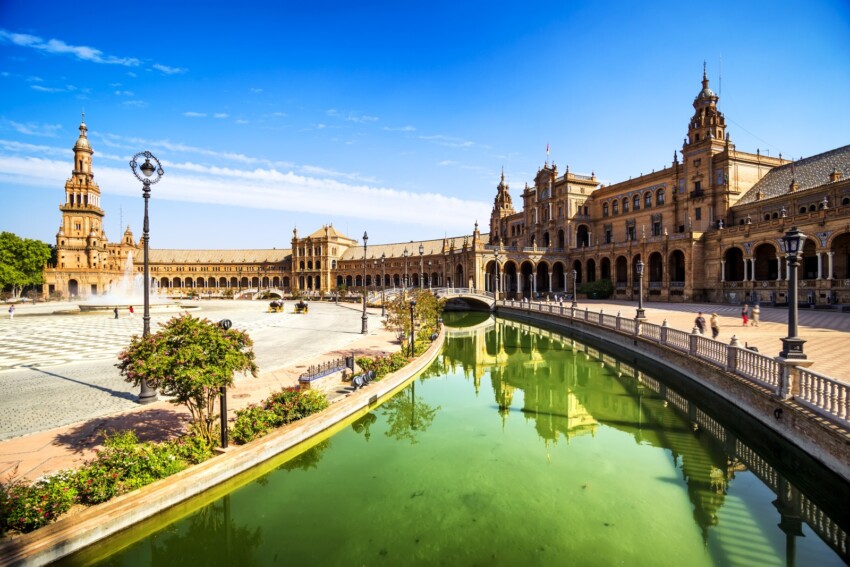
Plaza de España is one of the absolute symbols of Seville, and one of its most common postcards. It is located off the centre, south of the Barrio de Santa Cruz, beyond the Parque Maria Luisa. It is a huge semicircular square, built to celebrate the Ibero-American Exposition in Seville in 1929, designed by architect Hannibal Gonzalez. Work on its construction proceeded at such a fast pace that up to a thousand workers worked on it at the same time.
Today, almost 100 years later, Plaza de España is one of Seville’s main tourist attractions, thanks to its enormous size: more than 50,000 square metres, of which 20,000 are built-up and 30,000 are open space. There is also a canal, 515 metres long, which you can cross on a number of pedestrian bridges or even go along using small rowing boats that you can rent for the purpose.
The architecture of Plaza de España is very special: it is decorated in brick, marble and ceramics and has two towers, one to the north and one to the south. On the walls are ceramic benches and ornaments, representing the Spanish provinces placed in alphabetical order. The square, used as the setting for some famous films including Lawrence of Arabia, The Dictator and Star Wars Episode II, also has a fountain and a series of statues and bas-reliefs.
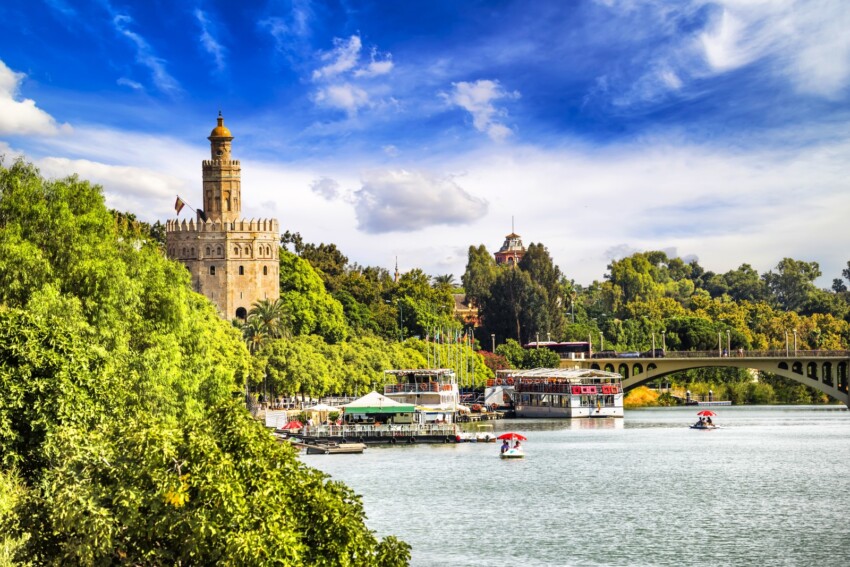
Along the Guadalquivir River, a short distance from the centre and not far from the Plaza de Toros, is a curious structure: it is the Torre del Oro, an ancient military control tower built as far back as 1220 in the Mudejar style, at the behest of the Almohad Caliph Aby Yakub Yusuf II. With a height of 36 metres, it is not difficult to imagine that at that time it was one of the tallest buildings in Seville!
Today, the Torre del Oro is one of the most characteristic buildings in Seville, mainly due to its 12-sided conformation. It consists of three sections, the first two of which are the original ones, while the third, cylindrical in the shape of a dome, dates back to 1700. Last restored in 2005, today the Torre del Oro houses the Seville Naval Museum, which contains engravings, letters and historical instruments, illustrating Seville’s naval history and the importance of the Guadalquivir River.
Climbing to the top of the tower also provides a beautiful view of the Cathedral and the entire city centre, as well as a privileged view of the river.
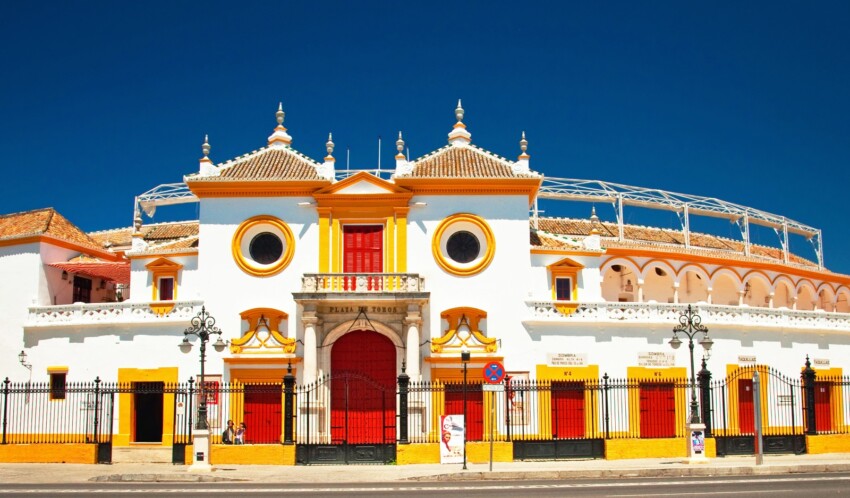
La Maestranza, officially Plaza de toros de la Real Maestranza de Caballería de Sevilla, is Seville’s plaza de toros. It is the oldest in Spain and it is here that the Feria de Abril, one of the most famous bullfighting festivals in the world, is held. With a total of 12,000 seats, this splendid bullring is one of the most popular tourist destinations in Seville, also because it is possible to take part in guided tours that allow you to discover all the secrets of this bloody and controversial fight between man and bull.
Built in 1760 in the Baroque style, the Maestranza has a main entrance overlooking the Guadalquivir, and once inside you will discover one of the most beautiful bullfighting arenas in the world. Its importance is so high that it is a privilege and an honour for bullfighters to perform here. At the same time, for bullfighting fans this arena is a sacred place, comparable to the hottest football stadiums internationally.
In addition, the Bullring of La Maestranza also houses the Taurino Museum, which displays historical documents, stage costumes, memorabilia and photographs of the bullfighters who have made bullfighting history, as well as thematic prints and paintings by important Spanish and international artists. Prominent among the works are 12 prints from the Tauromaquia series by Francisco Goya.
The General Archive of the Indies is a Spanish state archive, containing the records of the Spanish Empire in the Americas and the Philippines. It is housed in the palace of the Casa Lonja de Mercaderes, an old market built in the Spanish-Italian Renaissance style. Today, inside the Archive of the Indies, there are 9 kilometres of shelves, housing 43,000 volumes and a total of 80 million pages written by the colonial administrations.
Among the documents preserved are materials from the first Conquistadores, up to the last documents of the 19th century. Among the texts, there is a section dedicated to Christopher Columbus, with maps and plans of American colonial cities, and Miguel de Cervantes ‘ written request for an officer’s post. A huge digitisation project of the documents started in 2005, starting with the most endangered volumes.
The Archive of the Indies forms a unique UNESCO World Heritage Site together with the Cathedral, the Giralda and the Alcazar. It is possible to visit the building with or without access to the consultation rooms.
The Casa de Pilatos in Seville is a decidedly interesting monument, but – touristically speaking – of lesser importance than those already described. It is a palace built in typical Andalusian style inside and Italian-Mudejar style outside, housing the permanent residence of the Dukes of Medinaceli.
The construction of the palace began in 1483 and today it is an excellent example of the Spanish Renaissance. During your visit you will discover magnificent walls decorated with azulejos, interior gardens with flower beds and fountains, frescos of all kinds, and a chapel, like many palaces of the same period, built in Gothic and Mudejar style, with ancient decorations and numerous manuscripts.
Open to the public all year round, the Casa de Pilatos has also been chosen by many internationally renowned directors, such as Ridley Scott (1492 – The Conquest of Paradise) and David Lean (Lawrence of Arabia).
In the following map you can see the location of the main places of interest mentioned in this article.
Discover Seville through the eyes of expert guides who will take you on a tour of the city's hidden treasures. Participating in a guided visit or a free tour will allow you to capture the true essence of Seville.
The free tours are a viable alternative to traditional guided tours. They work like this: participation is free and at the end of the visit you can leave a tip at your discretion. Below you will find our favourite free tour, otherwise you can see the full list by visiting this page.
Few other cities are as attached to their traditions as Seville, which find their climax in the celebrations of Holy Week and the Feria de Abril.
The Semana Santa is experienced with participation and passion by the residents, who are joined by crowds of tourists attracted by the spectacular and world-famous processions. Those organised by the confraternities in the centre are solemn and austere, while those in the more popular neighbourhoods are showy and lively: the result is a unique mix of sacredness and popular joviality.
Particularly exciting is the night of Good Friday, with the processions of the confraternities starting around 1.30 a.m. and continuing until morning.
The more cheerful Feria de Abril, founded in 1847 as a livestock fair, is a great festive occasion, with music, dancing and food stalls in which Sevillians participate wearing traditional costumes.
Throughout the year in Seville you can enjoy exciting flamenco shows with singing and guitar accompaniment. Andalusia is the home of flamenco, the Spanish dance par excellence, and Seville is one of the best cities to get acquainted with this fascinating and mysterious art.
For a more exclusive experience, you can book a dinner and flamenco show package in one of the most prestigious tablao de flamenco, such as Los Gallos, or watch the most talented dancers perform in major theatres. For a more intimate and relaxed atmosphere, opt for one of the many bars with live shows.
The city is spread out on both sides of the Guadalquivir River, but the area of most interest to tourists is generally the eastern bank of the river.
The best areas to look for a hotel in Seville are the Barrio de Santa Cruz (convenient for visiting the Cathedral and the Alcázar), the centre (the part of the city north of Santa Cruz) and El Arenal (located west of Santa Cruz). In these areas you will find the best choice of hotels of all categories and traditional hostales (cheap hotels).
Unfortunately, Seville is a little more expensive than other places in Andalusia. If you are travelling during the high season, especially during the Semana or Feria de Abril, it is strongly recommended to book well in advance.
In July and August, hotel prices generally drop because the scorching heat is a deterrent for many tourists, who prefer to come here in cooler seasons such as spring or autumn.
Seville has an international airport that is connected to many European cities by direct flights, including low-cost airlines.
If you are already in Spain, you can reach Seville from Madrid in only two and a half hours by high-speed AVE trains or in about 6 hours by low-cost long-distance buses; from Barcelona, however, the journey is much longer. Seville is well connected by buses and trains with the main towns in Andalusia.
Although the public transport connections are good, consider renting a car as this allows you to travel through Andalusia, one of Spain’s most fascinating and romantic regions. With a rental car, you can also take unforgettable day trips, perhaps combining Seville with other beautiful Andalusian cities or a bit of relaxation by the sea.
What's the weather at Seville? Below are the temperatures and the weather forecast at Seville for the next few days.
Seville is the capital city of Andalusia, and is located in south-west Spain.
